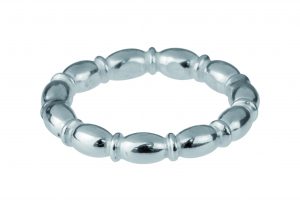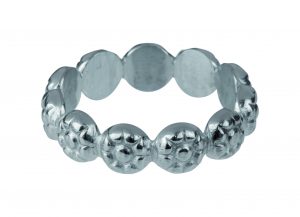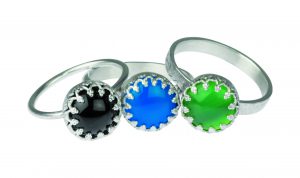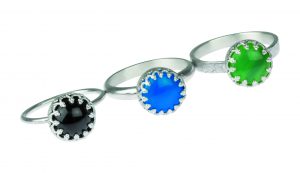Looking for ways to use gallery strip in your handmade jewellery projects?
Decorative gallery strip, otherwise known as gallery wire, is perfect for a variety of applications and can be easily transformed into a number of jewellery pieces. From using it to add a simple detail to a design to creating an eye-catching ring, there are plenty of ways you can incorporate gallery strip into your work.
To give you some inspiration, here are just a couple of ways to use gallery strip and beaded wire which you can consider when planning your next jewellery design.
Want to learn more about gallery strip first? Discover what it is and how versatile it can be in this blog article.
How to Make Silver Stacking Rings Using Gallery Strip
Follow this jewellery making project by Lydia Niziblian to discover how easy it is to make beautiful stacking rings using berry gallery strip or beaded wire.
Level of design: Beginner
What you’ll need:
- Sterling Silver Berry Gallery Strip (NVZ 023 or NVZ 024) and/or Sterling Silver Oval And Rondelle Beaded Wire (NVZ 028 or NVZ 026)
- Saw Frame (e.g. 997 3322)
- Saw Blades (e.g. 997 3323)
- Round Marked Triblet Sizes A-z+6, Steel (e.g. 997 3601)
- Needle files (e.g. 999 528)
- Nylon Ring Bending Pliers (e.g. 999 716)
- Easy Silver Solder Paste (PAT 021)
- Soldering Equipment (e.g. 999 096Q)
- Rawhide Mallet (e.g. 997 3118)
- Polishing Equipment (e.g. 999 096E)
- Optional: Emery Paper (e.g. 973 070)
Before you start
Trim the leading edge of your chosen strip or wire to the start of the design.
Step 1
Cut the strip or wire to the length you want (you can bend it around the triblet to the correct ring size first then mark it off). Saw the strip or wire at a clean junction, making sure you saw at a point that when the ring is soldered it will form a continuous design.
TIP: If necessary, err on the side of it being a little shorter than you want, as the finished ring should easily be stretched using a hide mallet and triblet.


Step 2
Use a needle file to file flat the edges that are to be soldered.
Step 3
Use ring bending pliers to bend the strip or wire into a ring shape, pushing the edges together neatly. Hold the ring up to the light to check that the joint is snug.
Step 4
Syringe a tiny amount of solder paste onto the join, and solder the join closed. Quench and pickle the ring.


Step 5
Tap the ring into shape using your rawhide mallet and triblet.
Step 6
Check the ring to see if the solder join needs any cleaning up – if so, you can do this with needle files or emery paper. Finally, polish the ring using your preferred method.
How to Make a Cabochon Ring with a Gallery Strip Setting
Find out how to create a ring featuring an inverted heart gallery strip cabochon gemstone setting in this step by step tutorial by Lydia Niziblian.
Level of design: Intermediate
What you’ll need:
- Your choice of metal for ring band, such as Sterling Silver D Shape Wire 3mm x 2mm (LSA 300), Sterling Silver Sheet 1mm (CSA 100) or Sterling Silver Round Wire 1.5mm (HSA 150)
- Saw Frame (e.g. 997 3322)
- Saw Blades (e.g. 997 3323)
- Nylon Ring Bending Pliers (e.g. 999 716)
- Needle files (e.g. 999 528)
- Hard Silver Solder Strip (CTD 500)
- Soldering Equipment (e.g. 999 096Q)
- Round Marked Triblet Sizes A-z+6, Steel (e.g. 997 3601)
- Rawhide Mallet (e.g. 997 3118)
- Sterling Silver Inverted Heart Small Gallery Strip (NVZ 029 or NVZ 020)
- 10mm round cabochon gemstone (e.g. blue agate 61AG CA01 or 61AG GA10)
- Side Cutters (e.g. 999 3053)
- Easy Silver Solder Paste (PAT 021)
- Sterling Silver Sheet 0.5mm (CSA 050)
- Optional: Steel Mesh (e.g. 860 092)
- Wet and Dry Paper (e.g. 975 070)
- Polishing Equipment (e.g. 999 096E)
- Metal Burnisher (e.g. 999 AJL) or Agate Burnisher (e.g. 997 1662)
Step 1
Cut the chosen metal for your ring band to the desired size, then use your ring bending pliers to bend the metal for the ring band so the edges are touching.
Step 2
Use a flat needle file to make sure the two edges of the metal are clean and fit together snugly. Hold the ring up to the light when the edges are pushed together to ensure you have a good join.
Step 3
Place a small pallion of hard solder onto the join of your fluxed ring, and solder then quench.
Step 4
Place the ring on the triblet and tap with a rawhide mallet to shape.


Step 5
Use a needle file to tidy up the ring. If using a D shape band, file a flat plane on the edge as this will make it easier when soldering onto the gallery strip setting later.
Step 6
Wrap your chosen gallery strip tightly around your gemstone. Cut at the overlap using side cutters, or mark and saw where required. Use ring or half round pliers to line up the edges neatly, ready to solder.
TIP: Ensure your overlap is neat, so the pattern of the wire will run smoothly.
Step 7
Flux the join and place the gallery strip on a tiny pallion of hard solder. Solder, heating gently to avoid overheating the wire edges. Quench, then check the gemstone fits comfortably into the setting with no gaps. Remove the stone.
Step 8
Flip the setting over, and syringe easy solder paste around the base, then pace the setting onto a piece of 0.5mm sheet just larger than the setting. Ideally you want to heat the piece from beneath to avoid melting the gallery strip, so use steel mesh to raise the setting and heat from below then quench.
TIP: Alternatively, you can turn the setting upside down and heat the base of the setting to solder.


Step 9
Carefully saw around the base of the setting and use a needle file followed by fine wet and dry paper to file the setting smooth. You should now have a smooth bezel cup ready to solder to your ring band.
Step 10
Place the setting upside down on your soldering block, squeeze a small amount of easy solder paste into the centre, and hold your ring band in place with tweezers. The flat edge you filed earlier should be flush to the back of the setting. Solder the pieces together, then quench and pickle.
Step 11
Polish the settings using your preferred method (using a barrelling machine is ideal for this). Gently push your gemstone into the clean, dry and polished setting.
Step 12
Use a burnisher to gently push the setting over the stone. Start at the cardinal points, and gradually work your way around, ensuring the setting is flush to the top of the stone. If needed, give your piece a final polish.
Feeling inspired? Get started with using gallery strip and beaded wire today by taking a look at our varied selection – with so many decorative designs available, there are plenty of ways you can add it to your jewellery making projects. Don’t forget you also can download a copy of the above stacking ring and cabochon gemstone ring tutorials to print and use in your own workspace!


Cooksongold




